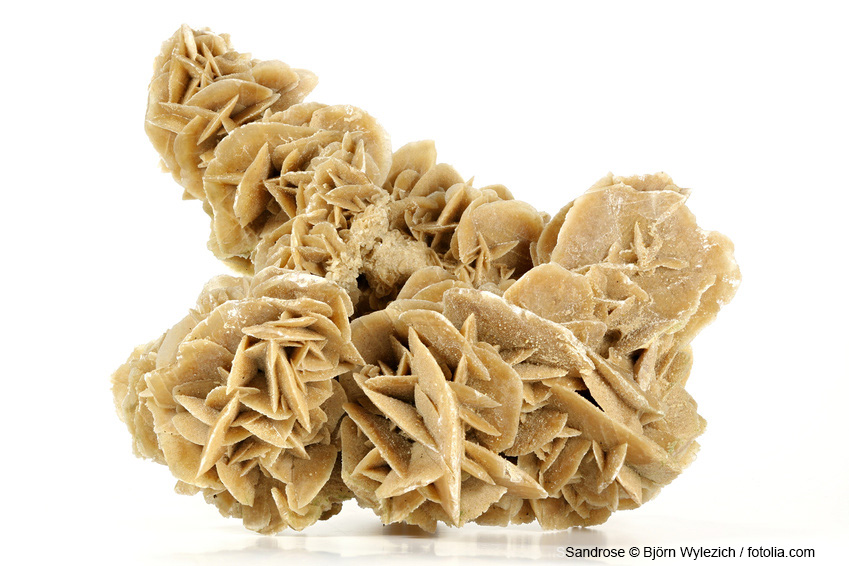The majority of naturally occurring barium sulphate (BaSO4) is used in oil and natural gas production. Barium sulphate is used to increase the density of drilling muds and in this way, rocks can move freely and thus prevents the borehole from becoming blocked up. Technical applications include fillers and additives in products such as linings for brake pads and clutches as well as floor linings. The medical field makes use of barium sulphate in X-ray contrast agents and in bone cement where in most cases a mixture of micro- and nano-scaled particles is used. Synthetically produced barium sulphate is known as “permanent white” and is used mainly in the paint industry (base coat and fillers in automotive coatings, industrial coatings, paints for the construction, wood and printing industries).

Radiologist administering contrast agent for MRI ©potthoff / fotolia.com
How can I come into contact with this material?
The consumer rarely comes into contact with barium sulphate as it is used mainly as filling material during the manufacturing of various technical products. For medical applications however the situation is totally different since barium sulphate is administered directly to humans either as an X-ray contrast agent for improved imaging or as bone cement.
Is there any risk from this material to humans and the environment?
Administered X-ray contrast agents that contain barium sulphate are not taken up by the gastro-intestinal tract due to the materials’ insolubility. This makes barium sulphate an ideal imaging agent for highlighting the shape of the digestive tract during X-ray examinations and the material is subsequently excreted unchanged. Studies have also confirmed that inhaled barium sulphate nanoparticles don’t accumulate in the lungs and do not cause any harm to lung tissue. Barium sulphate nanoparticles are also not able to cross the blood-brain barrier.
Up to this point in time, there is no experimental information regarding the behaviour of barium sulphate nanoparticles in the environment.
Conclusion
In general, the human body and environment are only exposed to very small amounts of barium sulphate nanoparticles. In the case of medical uses, barium sulphate nanoparticles do not cause any harm to the human body.
By the way…
- As barium sulphate is a particularly good absorber of X-ray and gamma radiation, it can be used in combination with concrete for shielding purposes in nuclear power plants.
- The most important natural mineral deposit for barium sulphate in Germany is located in Meggen, Westphalia.
Properties and Use

Baryte © M.Dorr & M.Frommherz / Fotolia.com
Barium sulfate (BaSO4) is the barium salt of sulfuric acid. The term “barium” is derived from the Greek word barys = heavy, which indicates the element’s high atomic weight. Barium sulfate is practically insoluble in water, acids (an exception being hot concentrated sulfuric acid), and bases. Due to its extremely low water solubility, barium sulfate, as compared to other barium compounds, is non-toxic.
Today, barite (heavy spar) is the only technically used base material for all barium compounds and for barium metal. The major quantity of the barium sulfate that is won by mining is used in oil and natural gas production to obtain high-density drilling fluids for flotation which keeps the boreholes free of rock.
Barium sulfate, moreover, serves as filler (filling spar) in the plastics and the paint and varnish industries. It increases the plasticity and weight of plastic materials that are used for sound insulation in e.g., car mats, carpet coatings, or plastic sewage pipes. The chemical inertness and high temperature stability of barium sulfate are made use of in friction linings. Clutch and brake linings, for example, may contain up to 40 % barium sulfate.
In the paint and varnish industry, high-quality barium sulfate is used as filler mainly due to its inertness and high density. It improves the volume and consistency, viscosity and workability of e.g., fillers, surfacers, and primers. Blanc-fixe, a synthetic from of barium sulfate, is added for easy glazing of glossy papers and photographic papers (barite papers). Burning of such papers leaves whitish barium sulfate deposits. In the textile industry, barium sulfate is found as a finish for linen goods and an agent for rayon matting during etching and printing. Due to its high coefficient of absorption for gamma radiation and X-radiation, barium sulfate is used in concrete (barite concrete, barite cement) that screens nuclear reactors. It is contained, in addition, in numerous radio-opaque substances (radio-opaque barite).
About 70 % of the blanc-fixe produced is used in coating compounds. Blanc-fixe is brighter than barite. It comes in different particle sizes for use in e.g., primers and fillers for automobile finishing, industrial varnishes, building paints and construction coatings, wood varnishes, and printing inks. In covering coats and enamels, it is used as “spacer” to improve titanium dioxide pigment scattering or to avoid flocculation of organic or inorganic colored pigments. Compounds that consist of zinc sulfide and barium sulfate as a white pigment (lithopone) have become less important.
Blanc-fixe is used to improve the plasticity of plastics and serves as “spacer” (see above) for white pigments and colored pigments. Moreover, it is applied to increase the surface hardness and scratch resistance of polyolefins, to produce tintless white films or translucent plastics and to enhance the plasticity of many types of semi-crystalline thermoplastics. Medical devices such as catheters or drainage pipes, and toys which may be swallowed by children benefit from the powder’s capability to absorb X-radiation. Likewise, blanc-fixe improves the frictional behavior of particular synthetic-fiber surfaces. The substance plays a secondary role today as filler in the paper industry.
Barium sulphate is not self-inflammable as nanometer-sized powder. Also as a mixture with air (dust) under the influence of an ignition source, barium sulphate is not inflammable, so there is no possibility of a dust explosion.
Occurrence and Production

Desert Rose © Bjorn Wylezich / fotolia.com
In nature, barium sulfateis found as crystals which due to their high density are referred to as barite (heavy spar). Intergrowth of the crystals causes the formation of so-called barite roses. One of the rare manifestations of such barite roses in desert sand is called "desert rose". The main heavy-spar deposits in Germany are located in Westphalia near the small town of Meggen. Considerably larger deposits are found in China which, in addition, ranks first in barium sulfate mining. The naturally occurring type of barium sulfate is used most commonly. For applications that require very pure white colors, barium sulfate is obtained by precipitation as “blanc-fixe” (permanent white).
NanoCare Data Sheets
Further Information
- Kittel, H (1998). Lehrbuch der Lacke und Beschichtungen. 2. Auflage, Hirzel-Verlag, ISBN3777608858.
- Gaechter, R & Mueller, H (1990). Taschenbuch der Kunststoffadditive. 3. Ausgabe, Hanser Fachbuchverlag, ISBN 3446156275.
Only the administration of very high doses of barium sulphate has a negative effect on viability. Neither in laboratory experiments with cells nor in animal experiments does it show any harmful effects.
Studies on Living Organisms – in vivo
Inhalation experiments on rats have shown that barium sulfate is not deposited in the lung but is completely removed again as the respiratory passages of the animals are cleaned. In medicine, this process is referred to as clearance: Mucus, bacteria, and foreign matter are removed from the body or, in this case, from the respiratory tract, to keep the latter free and avoid infections .
Within the project NanoCare, both intratracheal instillation tests and inhalation experiments were performed on rats. While a particle suspension is instilled into the pharynx in the case of instillation, the rats inhale the particles through the nose over a defined period of time in the case of inhalation. Neither the instilled nor the inhaled barium sulfate particles showed any biological effects in the different organs of the animals examined subsequently .
Studies Outside of Organisms – in vitro
In vitro experiments performed on human lung cells within the project NanoCare have shown that these cells get stressed and lose their vitality only after administration of very high doses of 50 µg particles per cm2 cell lawn. This dose is not only far above the dose of natural exposure but also above the one occurring during correct use of barium sulfate. Tests on ten different cell lines of different proveniences with up to 10µg particles per cm2 cell lawn revealed that only embryonic stromal cells of mice were suffering from reduced cell vitality and stress. To any of the other cell lines, BaSO4 did not cause effects damaging the cells .
In addition to simple culture systems with only one cell line, also complex so-called co-culture systems were studied within NanoCare. Using such systems, the in vivo situation in the body can be displayed better due to simulation of the interaction of the cells. In these systems, barium sulfate particles did not trigger any biological effects and the cells were found to remain vital.
Based on the so-called vector model representing some of the elementary cell functions , partners of NanoCare have proved that BaSO4 causes the least effects of all materials tested. A concentration of more than 120µg particles per 106 macrophages (total overload for the cells) was found to lead to damage of the cells. Although that dose is ultra-high, reactive oxygen species (ROS) were not detected in the cells.
There are no data regarding environmental exposure with barium sulphate nanoparticles available.
Inhaled barium sulphate does not deposit in the lungs and does not cause any biological effects. If it is absorbed via the gastrointestinal tract, it is excreted unchanged. There are no scientific studies available on the uptake of barium sulphate particle via the skin.
Uptake via the Lung – Inhalation
Experiments have shown that inhaled BaSO4 is removed again through self-cleaning (clearance, expulsion of mucus, bacteria, and foreign matter from the lung) . Long-time studies have not been available so far.
Uptake via the Gastro-Intestinal Tract
Dentists use barium sulfate as an adhesive gel. Due to its high impermeability to X-radiation, BaSO4 is used, in addition, as a contrast agent with high X-ray absorption. Mostly, barium sulfate is used in the form of hardly soluble suspensions. The particles are not resorbed. When used as a contrast agent visualizing the intestinal tract, barium sulfate is excreted in its unchanged form as “white stool”.
No data are available regarding the uptake and risk of barium sulphate particles for environmental organisms.
Barium sulphate particles are absorbed into different cell types in the body. The uptake mechanism has not yet been investigated for these special particles.
Behaviour at the Blood-Brain Barrier
No barium sulphate (BaSO4) particles were found in brains of rats during in vivo studies within the project NanoCare. Since clearance in the lung starts after particle inhalation, the BaSO4 is not transported through the body of the animals .
There are no data available regarding the behaviour of barium sulphate nanoparticles under environmental conditions.
 >
>